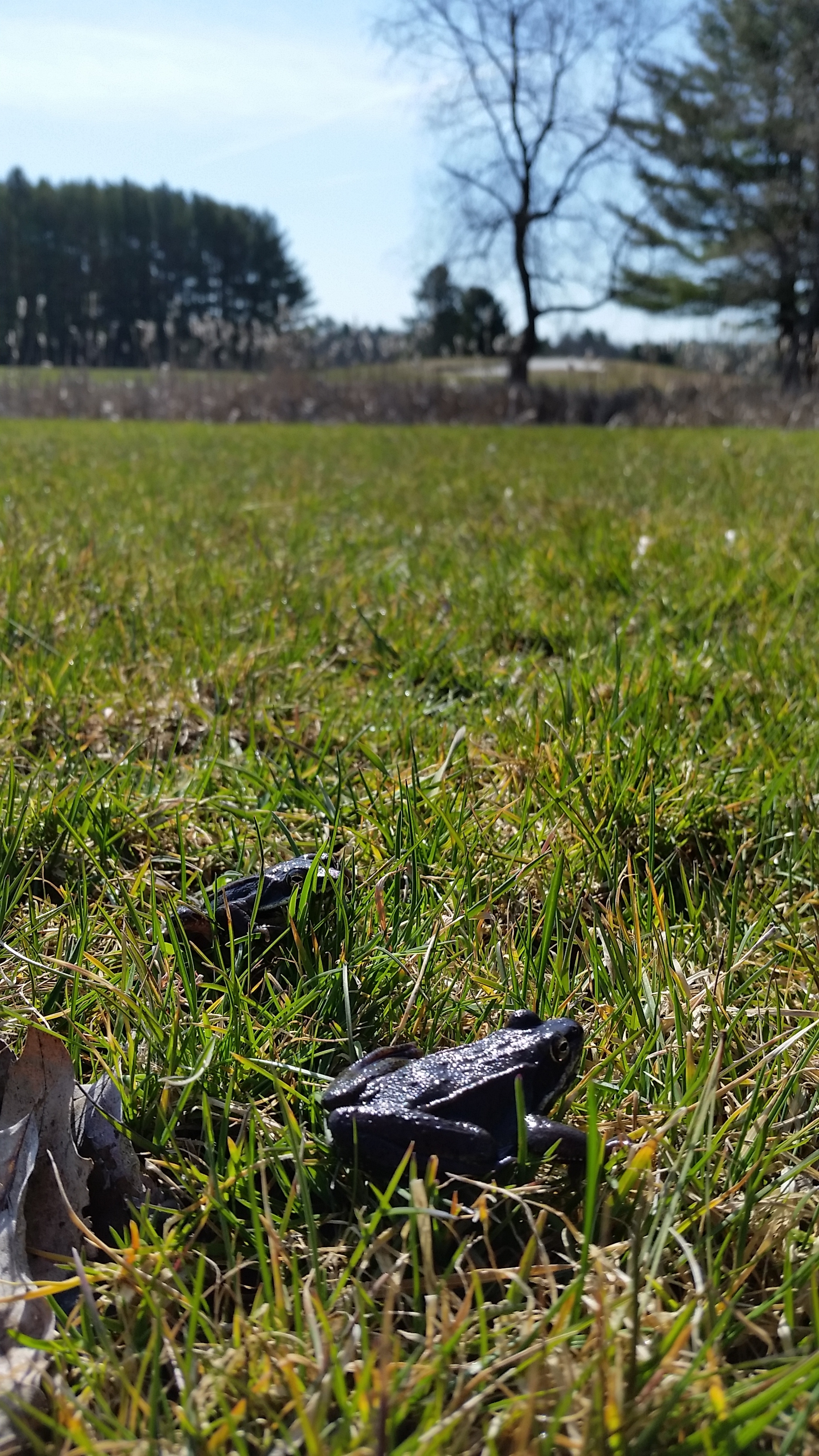Mitchell Jones, PhD student, University of Maine
The Bangor Municipal Golf Course is one of two Audubon Sanctuary courses in Maine. This certification acknowledges steps taken by the course to protect the environment by reducing environmental impact. Examples include reducing the use of fertilizers and pesticides, reduction of mowed areas, and identifying and maintaining wildlife habitats. The vernal pool ecology lab in the wildlife, fisheries, and conservation biology department has graciously been allowed to study two pools that act as breeding habitats for wood frogs, spotted salamanders, and blue spotted salamanders. One is a small pond on the 15th hole, the other is just off the path by the greens on the 6th hole of the Kelly 9. Our research is focused on understanding how the landscape surrounding a vernal pool affects the amphibians that use it. For the past two weeks we have been trapping adult amphibians from 10 pools, including the two at the golf course.
 The pond off the 15th hole seems to be somewhat polarizing for golfers, course managers, and even researchers. From a golfer’s perspective, you cannot see the pool from the tee box; therefore you cannot see the ball land in the pool if your shot is a bit right. This means (according to the rules) it’s a lost ball and you have to start over from the tee instead of dropping the ball beside the pool. This seems to bother some more than others and the degree to which this rule is followed varies by player. From a course management standpoint there is a balance between keeping customers happy, keeping the course dry, and fulfilling Audubon Sanctuary guidelines. We have talked to staff that love the pool and the little ecosystem it contains, and others who would love to fill it in. From the researcher’s perspective, the pool is somewhat of an anomaly; it certainly isn’t natural in its current state and some argue it only appears to function and couldn’t possibly be good habitat. However, those of us who have spent the most time in the pool and seen the diversity know it’s quite productive. In our two weeks of trapping this spring we caught dozens of amphibians, including wood frogs, green frogs, spotted salamanders, and blue spotted salamanders. We spooked ducks in the water almost daily and on a few occasions the ducks spooked us.
The pond off the 15th hole seems to be somewhat polarizing for golfers, course managers, and even researchers. From a golfer’s perspective, you cannot see the pool from the tee box; therefore you cannot see the ball land in the pool if your shot is a bit right. This means (according to the rules) it’s a lost ball and you have to start over from the tee instead of dropping the ball beside the pool. This seems to bother some more than others and the degree to which this rule is followed varies by player. From a course management standpoint there is a balance between keeping customers happy, keeping the course dry, and fulfilling Audubon Sanctuary guidelines. We have talked to staff that love the pool and the little ecosystem it contains, and others who would love to fill it in. From the researcher’s perspective, the pool is somewhat of an anomaly; it certainly isn’t natural in its current state and some argue it only appears to function and couldn’t possibly be good habitat. However, those of us who have spent the most time in the pool and seen the diversity know it’s quite productive. In our two weeks of trapping this spring we caught dozens of amphibians, including wood frogs, green frogs, spotted salamanders, and blue spotted salamanders. We spooked ducks in the water almost daily and on a few occasions the ducks spooked us.
 Love it or hate it, the pool on 15 seems to be a functional remnant of a larger ecosystem that once covered the entire Bangor area, long before we built golf courses, airports, or downtown. Personally, I am more of a hacker than a golfer, and pond or not I lose a lot of balls when playing 18 holes. As a result, I’ve never played strictly by the rules, and have dropped probably more than my fair share of balls somewhere in the neighborhood of the woods or water I was certain swallowed had the last one. While talking with the staff and players at the course I found that many of them appreciate what the pond brings to the course. Despite the fact that it can be a bit of a nuisance to the game, when we zoom out to the bigger picture it’s pretty cool that this messy little ecosystem is surviving smack dab in the middle of a well-manicured golf course.
Love it or hate it, the pool on 15 seems to be a functional remnant of a larger ecosystem that once covered the entire Bangor area, long before we built golf courses, airports, or downtown. Personally, I am more of a hacker than a golfer, and pond or not I lose a lot of balls when playing 18 holes. As a result, I’ve never played strictly by the rules, and have dropped probably more than my fair share of balls somewhere in the neighborhood of the woods or water I was certain swallowed had the last one. While talking with the staff and players at the course I found that many of them appreciate what the pond brings to the course. Despite the fact that it can be a bit of a nuisance to the game, when we zoom out to the bigger picture it’s pretty cool that this messy little ecosystem is surviving smack dab in the middle of a well-manicured golf course.
